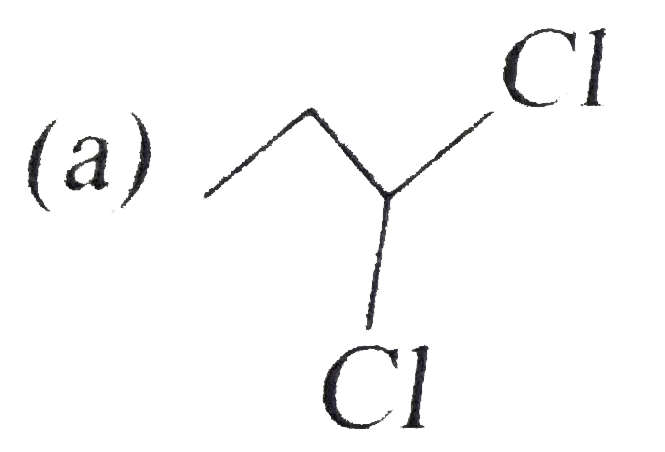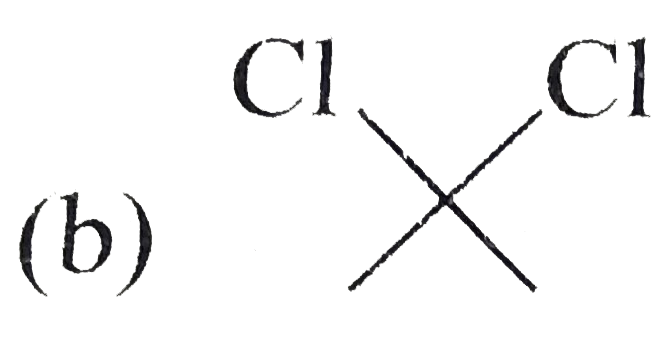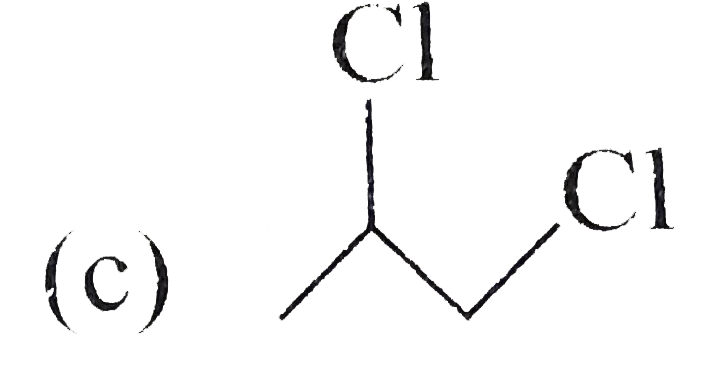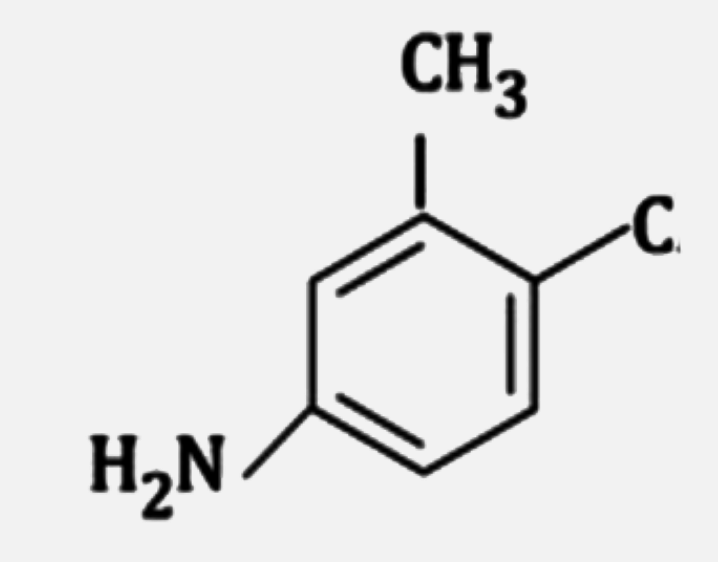Consider the following sequence of reactions
AC3H6Cl2alc.KOH−−−−−→△BB2H6−−−−−−→H2O2/ΘOHC,Aaq.KOH−−−−→△C.
The compound A is :




The correct Answer is:A
To determine the compound A in the given sequence of reactions, we will analyze the reactions step by step.
Step 1: Identify the structure of compound A
The question states that compound A is a dichloro compound with the formula C₃H₆Cl₂. This indicates that A has three carbon atoms and two chlorine atoms. Given that it is a dichloro compound, we can assume that the chlorines are likely on adjacent carbons, leading to a structure that can undergo elimination reactions.
Hint: Look for a structure that has two chlorine atoms on adjacent carbons.
Step 2: Reaction with alc. KOH
When compound A reacts with alcoholic KOH and is heated, it undergoes an elimination reaction (dehydrohalogenation). This reaction will remove HCl from the compound, resulting in the formation of an alkyne (B). Since we are starting with a dichloro compound, we can expect that the elimination will lead to the formation of a triple bond.
Hint: Consider the mechanism of elimination reactions and how they lead to the formation of alkynes.
Step 3: Identify compound B
After the elimination reaction, compound B will be an alkyne. Given the structure of A, we can deduce that B is likely to be propyne (C₃H₄), as it is formed from the removal of two chlorine atoms and two hydrogen atoms.
Hint: Remember that the product of elimination reactions involving dichloro compounds often leads to terminal alkynes.
Step 4: Hydroboration-oxidation of B
Next, compound B (propyne) undergoes hydroboration-oxidation with B₂H₆ followed by H₂O₂ in the presence of OH⁻. This reaction will convert the terminal alkyne into an aldehyde (C). The hydroboration step adds boron to the less substituted carbon, and the subsequent oxidation replaces the boron with an OH group, resulting in the formation of an aldehyde.
Hint: Hydroboration-oxidation transforms terminal alkynes into aldehydes.
Step 5: Aqueous KOH reaction with A
The second reaction indicates that compound A also reacts with aqueous KOH. This reaction will lead to the substitution of the chlorine atoms with hydroxyl groups (OH), resulting in the formation of a gem-diol (C).
Hint: Aqueous KOH typically leads to nucleophilic substitution reactions.
Step 6: Conclusion
Based on the analysis, the compound A is identified as 3,3-dichloropropene (or a similar structure) which allows for both reactions to proceed as described. The final products C from both reactions are consistent with the expected outcomes.
Final Answer
The compound A is 3,3-dichloropropene.
---
The question states that compound A is a dichloro compound with the formula C₃H₆Cl₂. This indicates that A has three carbon atoms and two chlorine atoms. Given that it is a dichloro compound, we can assume that the chlorines are likely on adjacent carbons, leading to a structure that can undergo elimination reactions.
When compound A reacts with alcoholic KOH and is heated, it undergoes an elimination reaction (dehydrohalogenation). This reaction will remove HCl from the compound, resulting in the formation of an alkyne (B). Since we are starting with a dichloro compound, we can expect that the elimination will lead to the formation of a triple bond.
After the elimination reaction, compound B will be an alkyne. Given the structure of A, we can deduce that B is likely to be propyne (C₃H₄), as it is formed from the removal of two chlorine atoms and two hydrogen atoms.
Next, compound B (propyne) undergoes hydroboration-oxidation with B₂H₆ followed by H₂O₂ in the presence of OH⁻. This reaction will convert the terminal alkyne into an aldehyde (C). The hydroboration step adds boron to the less substituted carbon, and the subsequent oxidation replaces the boron with an OH group, resulting in the formation of an aldehyde.
The second reaction indicates that compound A also reacts with aqueous KOH. This reaction will lead to the substitution of the chlorine atoms with hydroxyl groups (OH), resulting in the formation of a gem-diol (C).
Based on the analysis, the compound A is identified as 3,3-dichloropropene (or a similar structure) which allows for both reactions to proceed as described. The final products C from both reactions are consistent with the expected outcomes.
The compound A is 3,3-dichloropropene.
Topper's Solved these Questions
- BOOK - HIMANSHU PANDEYCHAPTER - HALIDESEXERCISE - Level 2 (Q.101 To Q.125)25videos
HALIDES
- BOOK - HIMANSHU PANDEYCHAPTER - HALIDESEXERCISE - Level 2 (Q.126 To Q.150)25videos
HALIDES
- BOOK - HIMANSHU PANDEYCHAPTER - HALIDESEXERCISE - Level 2 (Q.51 To Q.75)25videos
HALIDES
- BOOK - HIMANSHU PANDEYCHAPTER - GENERAL ORGANIC CHEMISTRYEXERCISE - Subjective Type Problems19videos
GENERAL ORGANIC CHEMISTRY
- BOOK - HIMANSHU PANDEYCHAPTER - ISOMERISMEXERCISE - Subjective Type Problems11videos
ISOMERISM
Similar Questions
Knowledge Check
- Question 1 - Select One
What is Z in the following sequence of reactions?
ZPCl3−−→Xalc.KOH−−−−−→Y(i)Conc.H2SO4−−−−−−−−−→(ii)H2OboilZAH2C=CH−CH2−OHBCH3CHOHCH3C(CH3CH2)COOHDCH3CH=CH2 - Question 2 - Select One
Consider the following sequence of reactions
CH2=CH2PhCO3H−−−−−−→CH2Cl2Adil.H2SO4−−−−−−→B
The product (B) isAPhCH2CH2OHBCH2OHCH2OHC(CH3)2CHOCH2CH3DCH2OHCH2Cl - Question 3 - Select One
The acid D obtained through the following sequence of reactions is:
C2H5BrAlc.KOH−−−−−→ABr2−−→CCl4BKCN−−−−−→(excees)CH3O+−−−→ASuccinic acidBMalonic acidCMaleic acidDOxalic acid
Identify C in the following reaction.
EthanolPBr3−−→Aalc. KOH−−−−→B(i) H2SO4 R.T.−−−−−−−−−→(ii) H2SO4ΔCView SolutionThe acid S obtained through the following sequence of reactions is :
C2H5BrAlc.KOH−−−−−→PBr2−−→CCl4QKCN−−−−→(excess)RH3O+−−−→SView SolutionThe acid D obtained through the following sequence of reactions is:
C2H5BrAlc.KOH−−−−−→ABr2−−→CCl4BKCN−−−−−→(excees)CH3O+−−−→View SolutionConsider the following reactions sequence
Propan−1−olSOCl2−−−→Xalc.KOH−−−−−−→ΔY(i)B2H6/THF−−−−−−−−−−−−−→(ii)H2O2/NaOHZ (Major)
Product Z isView SolutionThe acid D obtained through the following sequence of reactions is:
C2H5BrAlc.KOH−−−−−→ABr2−−→CCl4BKCN−−−−−→(excees)CH3O+−−−→View Solution



